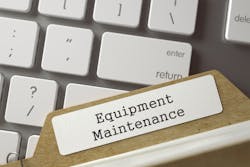Many years before safety-related maintenance requirements made it into NFPA 70E, presenters at conferences for the electrical testing industry asserted that if you didn’t have the maintenance history on a piece of equipment, you must assume the equipment is not in a safe condition. And you must approach the testing process with that in mind.
During Q&A sessions, this assertion would be challenged as paranoid or costly. Or a testing firm project manager would say something like, “I can’t tell my clients how to maintain their plant.” A reply such as, “Actually, you can,” would be followed by a discussion of why unmaintained equipment is unsafe equipment, and you have an obligation to make the job as safe as practical for your employees or to walk away from it.
Chapter 2 of NFPA 70E provides the requirements. It’s a short chapter consisting of 11 short articles. Each of these provides enough basic information for a qualified person to see the bright red line where safe meets unsafe.
Some key points:
- Equipment should be maintained per manufacturer’s instructions and/or industry standards [205.3]. For example, the manufacturer recommends lubricating a breaker mechanism annually based on the conditions of service but this is excluded from the maintenance procedure entirely. You must assume this breaker will not operate properly. Note that dried out lubrication is the No. 1 cause of breaker malfunction.
- Flexible cords and cables must be free of wear or other defects [205.14]. This includes cords and cables integrated with the equipment; don’t confine your thinking to portable cords.
- Covers must be in place [215.1] and raceways and cable trays must be in good mechanical condition so they provide protection and support for conductors [215.3]. If you walk into a facility and see covers missing half their bolts or not even installed, assume maintenance has been zero. The same goes for raceway that is falling apart.
- Fuses must be free of breaks or cracks in their cases, ferrules, and insulators [225.1]. Fuse clips and fuseholders should have enough grip to securely hold the fuses. If you see anything that is cracked, broken, or bent, you are looking at a safety problem resulting from lack of maintenance.
About the Author

Mark Lamendola
Mark is an expert in maintenance management, having racked up an impressive track record during his time working in the field. He also has extensive knowledge of, and practical expertise with, the National Electrical Code (NEC). Through his consulting business, he provides articles and training materials on electrical topics, specializing in making difficult subjects easy to understand and focusing on the practical aspects of electrical work.
Prior to starting his own business, Mark served as the Technical Editor on EC&M for six years, worked three years in nuclear maintenance, six years as a contract project engineer/project manager, three years as a systems engineer, and three years in plant maintenance management.
Mark earned an AAS degree from Rock Valley College, a BSEET from Columbia Pacific University, and an MBA from Lake Erie College. He’s also completed several related certifications over the years and even was formerly licensed as a Master Electrician. He is a Senior Member of the IEEE and past Chairman of the Kansas City Chapters of both the IEEE and the IEEE Computer Society. Mark also served as the program director for, a board member of, and webmaster of, the Midwest Chapter of the 7x24 Exchange. He has also held memberships with the following organizations: NETA, NFPA, International Association of Webmasters, and Institute of Certified Professional Managers.
